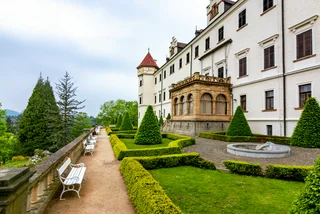An ornate centuries-old ceremonial shield is set to return to its rightful home in the Czech Republic’s Konopiště Castle. The 16th-century artifact, which has been on display in the Philadelphia Museum of Art since 1976, was stolen from Konopiště by the Nazis during World War II for display in a never-realized super museum planned by Adolf Hitler.
The elaborate “pageant shield,” which depicts the Roman storming of New Carthage in 209 B.C., will now join Konopiště’s impressive displays of historical armor collected by the previous owner of the castle, Archduke Franz Ferdinand, after a restitution agreement between the Philadelphia museum and the Czech Republic.

A thorough investigation of the shield confirmed its identity and origin. It was made in around 1535, with an intricate painted decoration attributed to Girolamo di Tommaso da Treviso, based on a design by Italian painter Giulio Romano. It is made of wood, linen, gesso, gold and pigment, and is around 60 cm in diameter. It is has now been taken off display in America ahead of transportation to the Czech Republic.
The shield was taken from Konopiště, along other items from the castle’s armor collection, by the Nazis in 1943. It was earmarked for use in a planned Nazi mega-museum in Linz, Austria, to be named the Fürhermuseum, which was never realized.
Little is known about how the shield ended up in America; it was bestowed on the Philadelphia Museum of Art in 1976 as part of a significant armor collection. It was first identified as the missing shield of Konopiště in 2016 by a Czech historian researching the castle’s artifacts.
“After eight decades, the shield will finally return home to the place in which it decorated Konopiště Castle for many years,” Lubomír Zaorálek, Czech Minister of Culture, said in a statement. “Justice prevailed over the despotism of the Nazi regime, which illegally stole this precious artifact dating back to the beginning of the 16th century.”
Archduke Franz Ferdinand, whose assassination in Saravejo in 1914 started World War I, was an avid armor collector and displayed a huge array of artifacts at Konopiště, which was his grand country residence.
Konopiště Castle is only a short train or cary journey from Prague. The castle was first built in the 14th century, before being transformed into a Baroque-style residence in the 19th century. Today, the castle remains largely as the Archduke left it at the time of his death.
Along with armor, the castle boasts a large collection of hunting trophies, and extensive grounds including a lake, forest, and a beautiful Rose Garden. The castle features various permanent and temporary exhibits, while guided tours take visitors through the most notable areas of the complex. A funeral mass for the murdered archduke is held every year on 28th June, the anniversary of his death, in the castle’s chapel.

One of the castle’s most remarkable and unexpected features is Jiři, a 15-year-old bear who lives in the eastern side of its moat. The complex also boasts historically-informed Czech cuisine at an on-site restaurant, which, combined with the glorious setting and the historical artifacts on display, helps whisk visitors away to the times of the archduke and the Habsburg Monarchy.












 Reading time: 2 minutes
Reading time: 2 minutes 






























